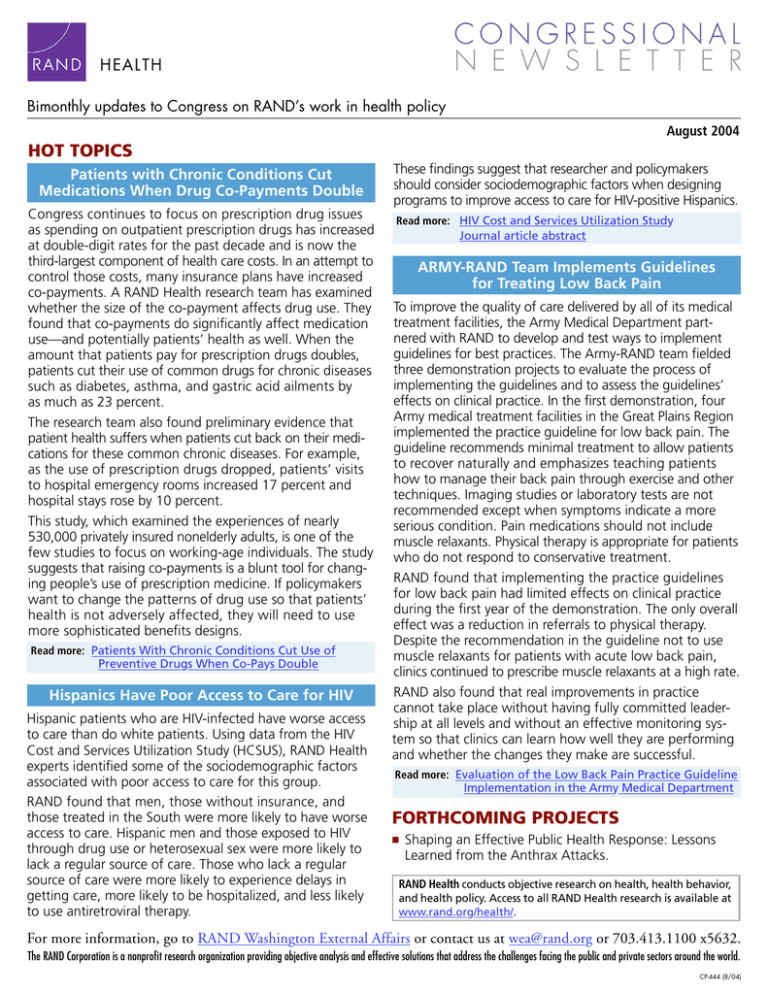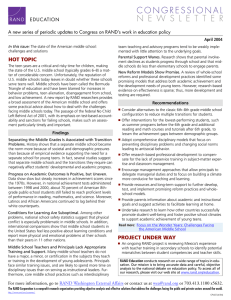HOT TOPICS Patients with Chronic Conditions Cut
advertisement

Bimonthly updates to Congress on RAND’s work in health policy August 2004 HOT TOPICS Patients with Chronic Conditions Cut Medications When Drug Co-Payments Double Congress continues to focus on prescription drug issues as spending on outpatient prescription drugs has increased at double-digit rates for the past decade and is now the third-largest component of health care costs. In an attempt to control those costs, many insurance plans have increased co-payments. A RAND Health research team has examined whether the size of the co-payment affects drug use. They found that co-payments do significantly affect medication use—and potentially patients’ health as well. When the amount that patients pay for prescription drugs doubles, patients cut their use of common drugs for chronic diseases such as diabetes, asthma, and gastric acid ailments by as much as 23 percent. The research team also found preliminary evidence that patient health suffers when patients cut back on their medications for these common chronic diseases. For example, as the use of prescription drugs dropped, patients’ visits to hospital emergency rooms increased 17 percent and hospital stays rose by 10 percent. This study, which examined the experiences of nearly 530,000 privately insured nonelderly adults, is one of the few studies to focus on working-age individuals. The study suggests that raising co-payments is a blunt tool for changing people’s use of prescription medicine. If policymakers want to change the patterns of drug use so that patients’ health is not adversely affected, they will need to use more sophisticated benefits designs. Read more: Patients With Chronic Conditions Cut Use of Preventive Drugs When Co-Pays Double Hispanics Have Poor Access to Care for HIV Hispanic patients who are HIV-infected have worse access to care than do white patients. Using data from the HIV Cost and Services Utilization Study (HCSUS), RAND Health experts identified some of the sociodemographic factors associated with poor access to care for this group. RAND found that men, those without insurance, and those treated in the South were more likely to have worse access to care. Hispanic men and those exposed to HIV through drug use or heterosexual sex were more likely to lack a regular source of care. Those who lack a regular source of care were more likely to experience delays in getting care, more likely to be hospitalized, and less likely to use antiretroviral therapy. These findings suggest that researcher and policymakers should consider sociodemographic factors when designing programs to improve access to care for HIV-positive Hispanics. Read more: HIV Cost and Services Utilization Study Journal article abstract ARMY-RAND Team Implements Guidelines for Treating Low Back Pain To improve the quality of care delivered by all of its medical treatment facilities, the Army Medical Department partnered with RAND to develop and test ways to implement guidelines for best practices. The Army-RAND team fielded three demonstration projects to evaluate the process of implementing the guidelines and to assess the guidelines’ effects on clinical practice. In the first demonstration, four Army medical treatment facilities in the Great Plains Region implemented the practice guideline for low back pain. The guideline recommends minimal treatment to allow patients to recover naturally and emphasizes teaching patients how to manage their back pain through exercise and other techniques. Imaging studies or laboratory tests are not recommended except when symptoms indicate a more serious condition. Pain medications should not include muscle relaxants. Physical therapy is appropriate for patients who do not respond to conservative treatment. RAND found that implementing the practice guidelines for low back pain had limited effects on clinical practice during the first year of the demonstration. The only overall effect was a reduction in referrals to physical therapy. Despite the recommendation in the guideline not to use muscle relaxants for patients with acute low back pain, clinics continued to prescribe muscle relaxants at a high rate. RAND also found that real improvements in practice cannot take place without having fully committed leadership at all levels and without an effective monitoring system so that clinics can learn how well they are performing and whether the changes they make are successful. Read more: Evaluation of the Low Back Pain Practice Guideline Implementation in the Army Medical Department FORTHCOMING PROJECTS ■ Shaping an Effective Public Health Response: Lessons Learned from the Anthrax Attacks. RAND Health conducts objective research on health, health behavior, and health policy. Access to all RAND Health research is available at www.rand.org/health/. For more information, go to RAND Washington External Affairs or contact us at wea@rand.org or 703.413.1100 x5632. The RAND Corporation is a nonprofit research organization providing objective analysis and effective solutions that address the challenges facing the public and private sectors around the world. CP-444 (8/04)





